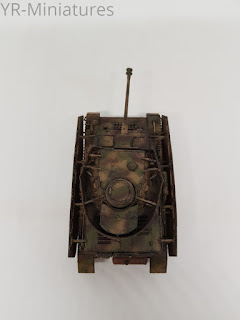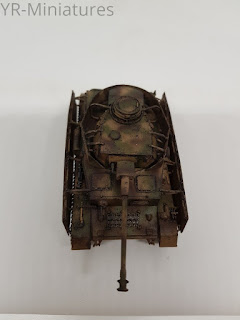The G variant of the Pz. IV was produced starting in May 1942. In April 1943 production began on the H variant—eventually the most massively produced version of the Pz. IV. The Ausf. H shared the upgraded gun of the Ausf. G, and utilized a single 80-mm front glacis plate instead of layered plates. A new transmission slightly reduced vehicle speed but was more reliable. The tanks of this variant also featured side screens, 5–8 mm thick, on the hull and turret sides. A total of 3,774 vehicles of the Ausf. H were built.
Model from Zvezda, built from box and painted with acrylics paints.

This is my personal blog about military models and miniatures from my collection.I collect Figures, Dioramas and Models since a long time ago. I will update the blog on a regular base. Some models and figures are available for selling, so fill free to ask any questions! You also may order commission work for miniatures painting or model building.
Showing posts with label 1/72. Show all posts
Showing posts with label 1/72. Show all posts
Wednesday, February 5, 2020
1/72 Sturmgeschutz III Ausf E
StuG III Ausf. E: (Sd.Kfz 142; September 1941 – February 1942, 284 produced) Superstructure sides added extended rectangular armoured boxes for radio equipment. Increased space allowed room for six additional rounds of ammunition for the main gun (giving a maximum of 50) plus a machine gun. One MG 34 and seven drum-type magazines were carried in the right rear side of the fighting compartment to protect the vehicle from enemy infantry. Vehicle commanders were officially provided with SF14Z stereoscopic scissor periscopes. Stereoscopic scissor type periscopes for artillery spotters may have been used by vehicle commanders from the start.
Model from Trumpeter, painted with acrylics paints.
Tuesday, February 4, 2020
1/72 Sd.Kfz.184 Ferdinand with 211 number (2 kompanie, s.Pz.Jg.Abt 653, Kursk 1943 )
Model from Trumpeter (07205), built from box, painted with acrylics paints and using different effects.
Monday, January 20, 2020
Wednesday, November 6, 2019
1/72 HMS Victory Cross-Section
HMS Victory Cross Section 1805
HMS Victory is a 104-gun first-rate ship of the line of the Royal Navy, ordered in 1758, laid down in 1759 and launched in 1765. She is best known for her role as Lord Nelson's flagship at the Battle of Trafalgar on 21 October 1805.
Made from metal and wooden parts using super glue. Painted with acrylics paints.
HMS Victory is a 104-gun first-rate ship of the line of the Royal Navy, ordered in 1758, laid down in 1759 and launched in 1765. She is best known for her role as Lord Nelson's flagship at the Battle of Trafalgar on 21 October 1805.
Made from metal and wooden parts using super glue. Painted with acrylics paints.
Subscribe to:
Posts (Atom)


























































